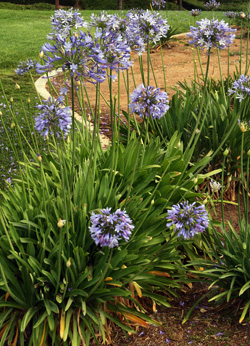Agapanthus Expanding Problems: Dirt, Sunlight, and Watering
Agapanthus Expanding Problems: Dirt, Sunlight, and Watering
Blog Article
Mastering the Art of Agapanthus Care: Essential Steps for Healthy Development and Vivid Blooms
In the world of cultivation, the cultivation of agapanthus stands as a satisfying endeavor for those that look for to nurture these sophisticated blooming plants. From picking the right selection to understanding trimming techniques, the trip in the direction of cultivating growing agapanthus plants is multifaceted and holds the vital to opening the full possibility of these agricultural gems.

Selecting the Right Agapanthus Range

When selecting the ideal Agapanthus range for your yard, think about factors such as climate viability, flower shade, and growth behavior. Furthermore, consider the environment in your region to make sure the Agapanthus range you pick can flourish in your specific conditions. Comprehending the development habit of different Agapanthus selections is important for proper positioning within your yard.
Suitable Growing Conditions
Considering the optimum environmental requirements is important for effective Agapanthus farming. Agapanthus grows in well-draining soil with a somewhat acidic to neutral pH level. When growing, pick a place that obtains full sunshine to partial color. In hotter climates, giving some afternoon shade can protect against scorching of the fallen leaves. Agapanthus plants are sensitive to cool temperature levels and must be protected from frost during winter season months.
To make certain healthy and balanced growth and dynamic blooms, plant Agapanthus bulbs at a depth of concerning 2-4 inches and space them 8-12 inches apart. Mulching around the base of the plants assists preserve wetness and reduces weed development.
Watering and Fertilizing Tips
Preserving proper dampness levels and giving crucial nutrients are crucial elements in the care program for Agapanthus plants. When it pertains to watering Agapanthus, it is vital to strike a balance. These plants like regularly damp dirt however are prone to root rot if overwatered. Throughout the growing period, water deeply when a week, guaranteeing the dirt is well-draining to stop waterlogging. In hotter climates or throughout periods of drought, more frequent watering may be required to maintain the dirt equally moist. Nevertheless, decrease watering in the winter to avoid waterlogged problems.
Feeding Agapanthus is important for advertising healthy growth and respected blooms. Apply a balanced plant food, such as a 10-10-10 formula, in the early spring as new development emerges. Repeat this application every 6-8 weeks throughout the expanding period. Prevent too much fertilizing, as it can result in rich foliage use this link at the cost of blossoms. Constantly follow the producer's guidelines for correct dilution and application approaches. By following these watering and feeding ideas, you can ensure your Agapanthus plants thrive and create vivid, long-lasting blooms.
Pruning Strategies for Agapanthus
Trimming Agapanthus plants at the proper times and with appropriate strategies is vital for keeping their wellness and promoting optimal growth and flowering. The optimal time to prune Agapanthus is in late winter or very early spring prior to brand-new growth arises.
For flowered stems, wait till the flowers have withered and after that cut them back to the base. This not just tidies up the plant's look yet likewise encourages the advancement of new check my site blossom buds. Deadheading spent blossoms can also reroute the plant's energy right into creating even more blooms as opposed to establishing seeds. Nevertheless, if you want to collect seeds for propagation, leave some blossoms to completely dry and mature on the plant.
Keep in mind to make use of tidy, sharp website link devices to make exact cuts and decrease the risk of introducing diseases. Agapanthus. Routine trimming will help keep your Agapanthus looking healthy and neat while guaranteeing a plentiful display of beautiful blooms
Taking Care Of Usual Insects and Illness
After ensuring correct trimming methods for Agapanthus, it is important to deal with typical parasites and conditions that can impact the health and vigor of these plants. Agapanthus plants are usually sturdy however can still drop target to certain problems. One usual insect that impacts Agapanthus is the Agapanthus gall midget. This small, orange fly lays its eggs in the vegetation, resulting in altered growth and flower buds that fall short to open. To combat this pest, prune and ruin any kind of damaged plant parts and think about using insecticidal soap.
Furthermore, Agapanthus plants can experience from origin rot if they are grown in poorly draining soil. By being cautious and taking punctual action against conditions and parasites, you can assist your Agapanthus plants grow and produce lively blooms. Agapanthus.

Final Thought
Finally, understanding the art of agapanthus treatment involves selecting the appropriate selection, supplying excellent planting conditions, proper watering and feeding, suitable pruning methods, and resolving usual bugs and conditions. By following these necessary actions, you can make certain healthy growth and lively flowers for your agapanthus plants. Keep in mind to regularly keep track of and keep your plants to promote their general well-being and longevity.
To make sure healthy and balanced growth and vivid flowers, plant Agapanthus light bulbs at a deepness of concerning 2-4 inches and area them 8-12 inches apart. By adhering to these watering and feeding ideas, you can ensure your Agapanthus plants prosper and produce lively, resilient flowers.
One common bug that impacts Agapanthus is the Agapanthus gall midge. Furthermore, Agapanthus plants can endure from origin rot if they are planted in poorly draining pipes dirt. By following these crucial steps, you can make certain healthy growth and vibrant blossoms for your agapanthus plants.
Report this page